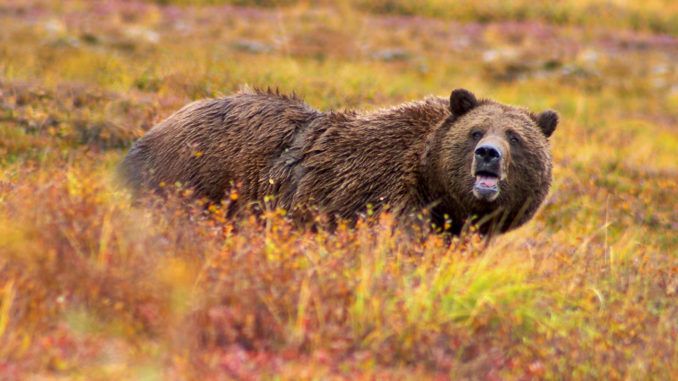
As sharks are to the sea, bears are to land. The polar bear is the largest carnivore outside of the oceans, capable of reaching a weight of more than a tonne, and #2 is the grizzly. Indeed, bears of one kind or another occupy six of the top nine slots – and that’s if you accept “liger” as a real animal, which… Yeah. And unlike sharks, there’s no foolproof, “staying out of the ocean” way of avoiding bears. Oh, you may think you’re safe in Britain. But just wait… Meanwhile, over here in Arizona, just a few months ago, a bear entered a cabin and attacked a teenager as he was watching TV. Last year, a man was dragged off and killed, about a hundred miles from here. Be right back. Checking the back door is secure.
What haunts me, is that in all the faces of all the bears… I discover no kinship, no understanding, no mercy. I see only the overwhelming indifference of nature.
— Werner Herzog
Make no mistake though: a bear can fuck you up. It’s bigger than you – even black bears will be around 350 lbs – can outrun you, reaching 40 mph, and can climb trees. It’s equipped with canines which can be longer than those of a tiger, and can apply in excess of a thousand PSI pressure. Its claws can be up to six inches long, and even if you survive the initial attack, the odds of subsequent infections are high, with the bear’s diet making their mouth a playground of bacteria. There’s a whole litany of advice on how to handle an attack. I particularly liked, “Behaving calmly, moving slowly, and speaking in a low calm voice will help de-escalate the situation.” It probably also works on Dodgers fans.
Needless to say, it has also proven fertile ground for film-makers, which is why we are here. The first killer bear movie appears to be 1966’s, The Night of the Grizzly, but the genre really took off after Jaws largely invented the killer animal genre. There’s no doubt that sharks have remained more prolific since, and sadly, we’ve never seen things like Bearnado. But every few years, someone remembers the ursine alternative, and breaks out the fur suit. Here, and for the next few Fridays, we’ll be reviewing the results, mostly in new reviews, though I’ll also lob Cocaine Bear in. A couple of limitations. I won’t include films like The Revenant, where the bear attack is only one element – albeit a real doozy in that example. I also require an actual bear to be involved. Technically, Winnie the Pooh: Blood and Honey is a bear attack movie. But, c’mon: it’s a guy in a mask. More’s the pity, I feel.
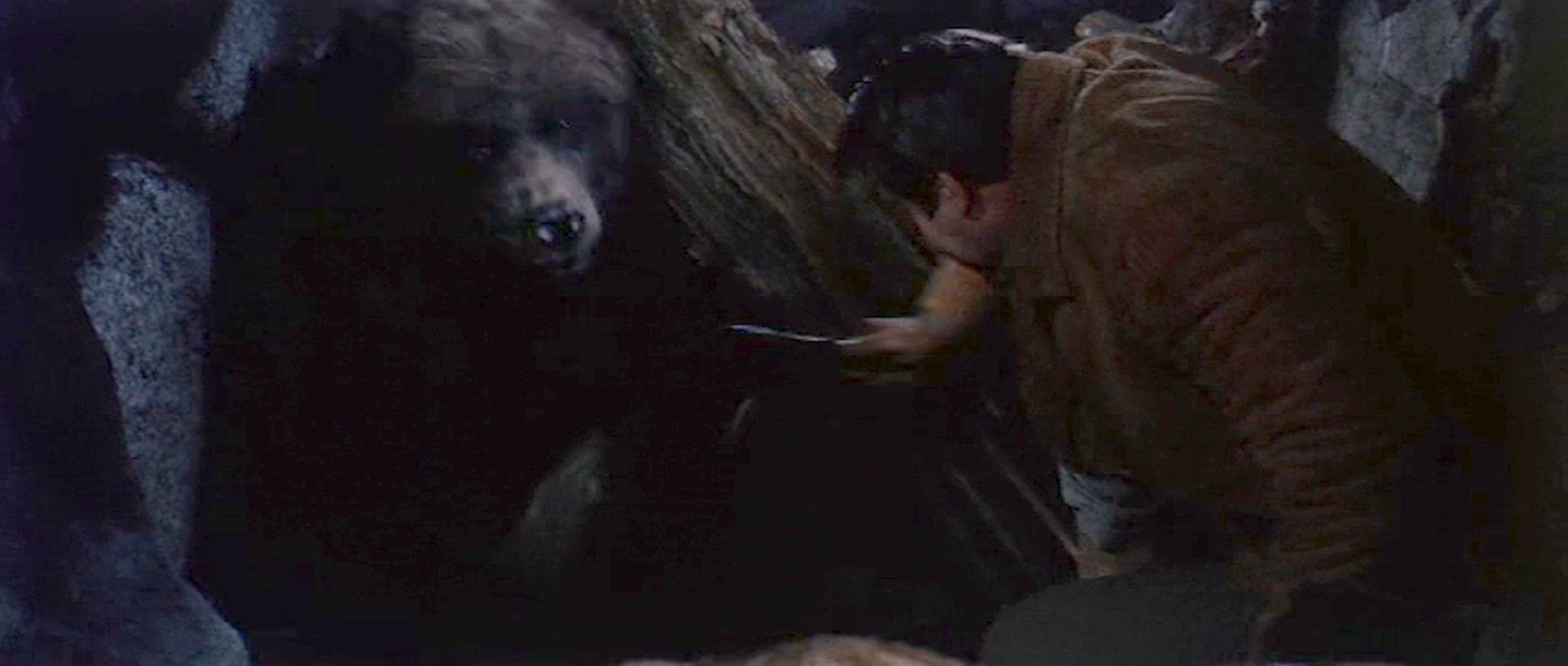
The Night of the Grizzly (1966)
Rating: B-
Dir: Joseph Pevney
Star: Clint Walker, Martha Hyer, Keenan Wynn, Jack Elam
In the end was the beginning. And so, we finish our survey of bear films with what is generally regarded as the first of the kind. It’s a straightforward yet likeable Western, with some good characters, and better than usual plotting for the genre. Former Marshall Jim Cole (Walker) arrives in Wyoming with his wife Angela (Hyer) and children, to take over the ranch he inherited. Two problems quickly raise their head. The land’s former owner, Jed Curry (Wynn), lost it in a poker game, and wants it back. While never resorting to illegal acts, Curry uses his influence to apply pressure on Cole e.g. telling the local banker not to help him financially.
Cole’s other issue is why it’s here: the presence of a notorious bear, subtly nicknamed Satan by the locals. His predations wipe out Jim’s livestock and his only recourse to replace them is a loan from Jeb, with the ranch as security. The local farmers put up a $750 reward which would clear Jim’s debt. But to make sure that doesn’t happen, Curry hires bounty hunter Cass Dowdy to kill the bear first. Dowdy spent two years in jail courtesy of Cole, back when he was a Marshall, so there’s history between them too. Angela becomes increasingly concerned for her husband’s safety, and overhearing his parents fight, son Charlie decides he should go after Satan, forcing his father into a search for both, with Dowdy running interference.
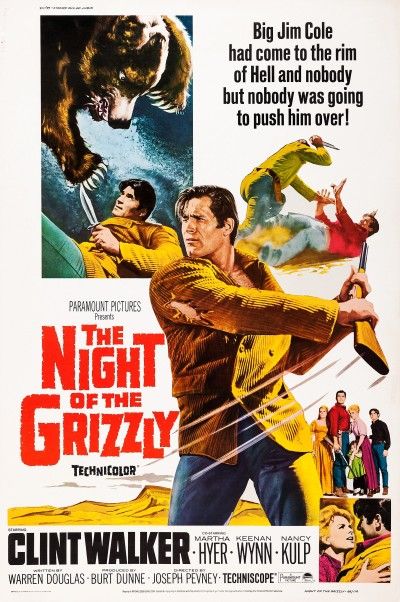 Walker had starred for seven seasons in the Cheyenee series – this was reportedly based off an unused script for the show. At 6’6″, gigantic for the time, he cuts an imposing figure. It feels as if, like eighties Tom Cruise, Walker had a contractual obligation to have at least one (1) scene in every film with his shirt off. Cole makes for a truly heroic figure, a devoted family man and upholder of the law. Things elsewhere are more nuanced: Curry may be underhanded, but sternly rebukes his sons for engaging in violence against Cole – which goes about as well for them as you’d expect! Dowdy, too, has humanity in him. He may not like Cole, but in the end endangers himself to protect the father and son.
Walker had starred for seven seasons in the Cheyenee series – this was reportedly based off an unused script for the show. At 6’6″, gigantic for the time, he cuts an imposing figure. It feels as if, like eighties Tom Cruise, Walker had a contractual obligation to have at least one (1) scene in every film with his shirt off. Cole makes for a truly heroic figure, a devoted family man and upholder of the law. Things elsewhere are more nuanced: Curry may be underhanded, but sternly rebukes his sons for engaging in violence against Cole – which goes about as well for them as you’d expect! Dowdy, too, has humanity in him. He may not like Cole, but in the end endangers himself to protect the father and son.
Just about everyone has interesting qualities, all the way down to Jim’s tiny moppet, Gypsy. Satan might be about the only exception, the bear being one-dimensionally evil. [There’s a lot of animal violence aftermath here, some of it disturbingly convincing] While obviously a model in close-up, the animal was played by a bear called Bozo, who would go on to greater fame as Ben, in The Life and Times of Grizzly Adams. The scenery here is lovely, and we thought about moving to Wyoming, until we discovered it was actually the San Bernardino National Forest. California: not so much. It remains a solid tale, honest in its simplicity, and well-told. Many bear movies would follow in its wake. Not many would be more enjoyable.
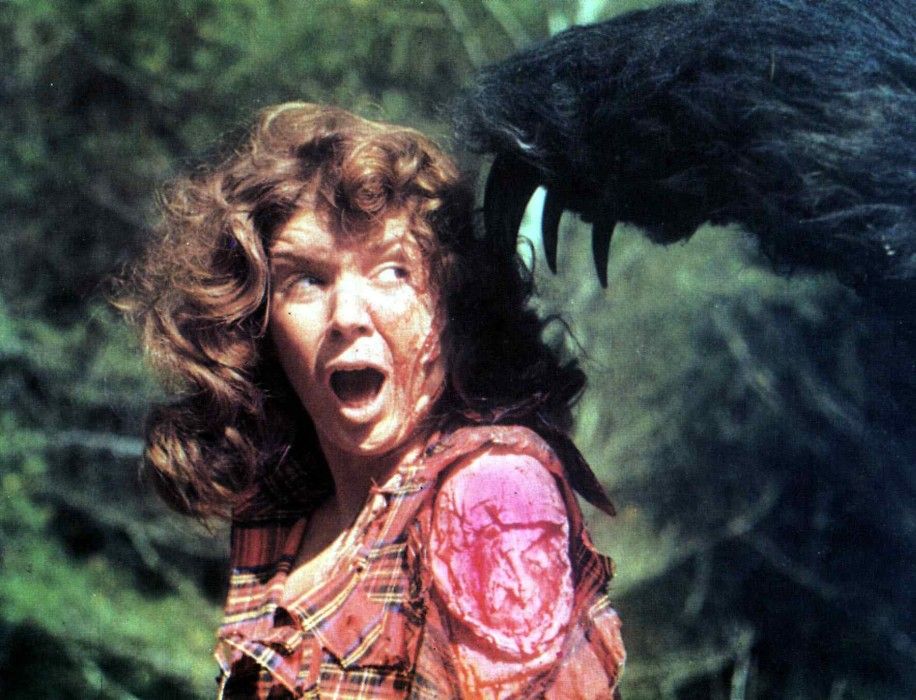
Grizzly (1976)
Rating: C+
Dir: William Girdler
Star: Christopher George, Andrew Prine, Richard Jaeckel, Joan McCall
In the wake of the massive success enjoyed by Jaws, the animal attack genre really took off. The rest of the decade include movies where the creatures in question were spiders, piranhas, killer whales and bees, but this one was likely among the most successful, especially relative to its budget. Costing three-quarters of a million dollars, it’s reported to have taken $39 million at the box-office, becoming the most successful independent film ever, holding the record until Halloween , two years later. Quite an impressive feat, considering this is more or less a shameless Jaws knockoff, which does little more than replace the shark with a bear, and a beach with a national park.
You can almost map the characters onto each other as well. Instead of police chief Brody, we get park ranger Michael Kelly (George). He is the one trying to keep visitors safe, organize a search for the murderous animal, and convince a local official – in this case, park supervisor, Charley Kittridge – to close the area for safety reasons. Just as in Jaws, the hero gets assistance from two quirky individuals, helicopter pilot Stober (Prine) and naturalist Arthur Scott (Jaeckel). There’s even a sequence where the official opens up the hunt to amateurs, and naturally, this goes about as well as in the Spielberg blockbuster. The main way this stands out is in its enthusiastic gore, all the more striking because this was rated ‘PG’ at the time of release.
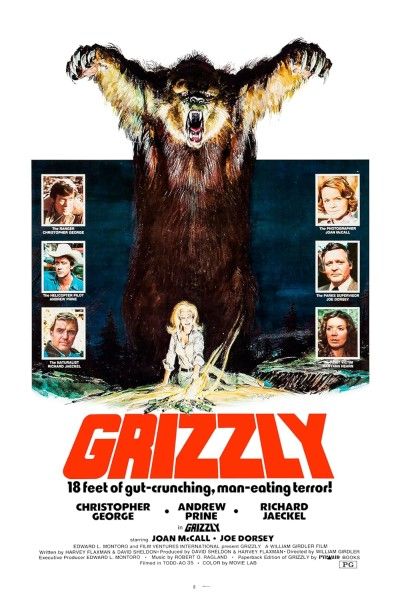 The bear maulings are easily the best thing about this. At times, this feels almost like it could be a precursor to Halloween In particular, the highly stalker-ish scene, heavy on attacker POV and exaggerated breathing, where the bear appears to be spying on a shapely park ranger taking a shower in a waterfall (the victim is played by Victoria Lynn Johnson, who’d go on to be Angie Dickinson’s body double in Dressed to Kill). It’s also so damn good at dismemberment. I was left wondering if it was carrying a Hattori Hanzō katana, since it can literally decapitate a horse with one sweep of its paw. Men, women, kids: it’s certainly an equal opportunity attacker. No wonder it requires heavy artillery to defeat it.
The bear maulings are easily the best thing about this. At times, this feels almost like it could be a precursor to Halloween In particular, the highly stalker-ish scene, heavy on attacker POV and exaggerated breathing, where the bear appears to be spying on a shapely park ranger taking a shower in a waterfall (the victim is played by Victoria Lynn Johnson, who’d go on to be Angie Dickinson’s body double in Dressed to Kill). It’s also so damn good at dismemberment. I was left wondering if it was carrying a Hattori Hanzō katana, since it can literally decapitate a horse with one sweep of its paw. Men, women, kids: it’s certainly an equal opportunity attacker. No wonder it requires heavy artillery to defeat it.
More or less everything else unfolds exactly as you’d expect, though sadly I didn’t quite get the scene I wanted, where the grizzly leaps up out of the forest to drag down Stober’s helicopter. Wilful government incompetence leads to unnecessary deaths, and we learn that lookout towers are no match for ursine strength, before Kelly has had enough and takes matters into his own hands. He’ll have to get through the bear’s plot armour first, because as well as carrying a sword, it seems to be sporting a Kevlar vest. Everyone here is so dumb, the animal is probably more intelligent than half the people, and you would be forgiven for losing attention during the human-based drama. I can’t deny being somewhat entertained, however.
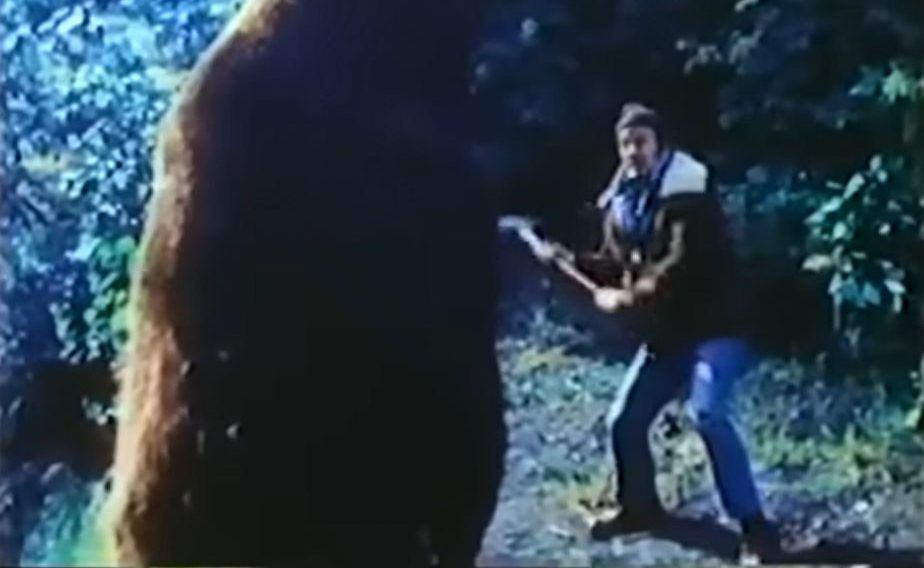
Claws (1977)
Rating: C
Dir: Richard Bansbach, Robert E. Pearson
Star: Jason Evers, Carla Layton, Leon Ames, Glenn Sipes
The title is such a shameless knock-off of a certain, highly popular animal attack film from a couple of years previously, it’s almost endearing. Yet to the writers’ credit, it does choose to be more than a total copy. In particular, there’s something personal about the man-bear relationship at its core, whose closest inspiration is Herman Melville’s doorstop novel, Moby Dick. As a result, I would be inclined to call this Grizzly Dick, except that sounds like an unpleasant STD, requiring a lengthy course of antibiotics. It begins with poachers wounding a bear in Alaska, causing it to go on a rampage, which begins by crippling logger Jason Monroe (Evers). The subsequent PTSD breaks up his marriage to Chris (Layton).
Five years later, the beast is still at large, occasionally popping up to maul the unwary, and has acquired an almost supernatural reputation as a “devil bear”. Jason re-enters the picture when it attacks a boy-scout camp, severely injuring his son, Buck. After other efforts to capture or kill the animal fail, Jason heads out into the wilderness to hunt his nemesis down, along with the local commissioner (Ames) and Chris’s new romantic interest, Howard Lockhart (Sipes). There’s also native American Henry, who imbues their prey with spiritual significance, tying it to his tribal belief in the Kushtaka, a shape-shifting creature. Due to various misfortunes, it’s largely down to Jason, albeit with a side-order of flare gun from Chris.
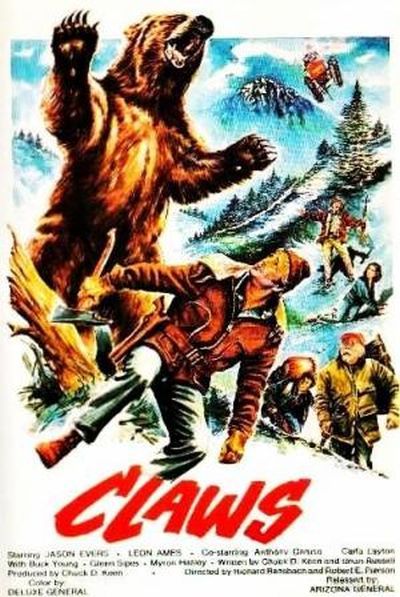 Genuinely filmed in Alaska, rather than faking it in British Columbia, the landscapes here are impressive. Cinematographer Chuck D. Keen, also co-writer and producer, does them justice. There’s some effort put into developing the characters, and the “folk horror” elements help explain some of the bear’s more, ah, mystical abilities. For example, when a group of scientists arrive, intending to trap the creature, it doesn’t just slaughter them, it leaves one victim dangling from the rafters as a surprise for the Commissioner when he opens their cabin door. Who knew bears could do that? On the other hand, the film under-estimates them, saying grizzlies can’t climb. Reality? “Three of the 23 documented bear-induced human injuries in [Alaskan national park] Denali involved grizzlies pulling humans out of trees.”
Genuinely filmed in Alaska, rather than faking it in British Columbia, the landscapes here are impressive. Cinematographer Chuck D. Keen, also co-writer and producer, does them justice. There’s some effort put into developing the characters, and the “folk horror” elements help explain some of the bear’s more, ah, mystical abilities. For example, when a group of scientists arrive, intending to trap the creature, it doesn’t just slaughter them, it leaves one victim dangling from the rafters as a surprise for the Commissioner when he opens their cabin door. Who knew bears could do that? On the other hand, the film under-estimates them, saying grizzlies can’t climb. Reality? “Three of the 23 documented bear-induced human injuries in [Alaskan national park] Denali involved grizzlies pulling humans out of trees.”
The problems are when the bear and humans get together, with multiple, staggeringly unconvincing efforts at attacks. [There is some decent footage of bears apparently fighting each other] This is particularly true at the end. In the final confrontation, it’s painfully obvious Jason and the live bear are never in the same shot. Much of this is filmed in slow-motion, likely in an effort to increase tension. It doesn’t, instead giving the viewer too much time to observe the flaws, then consider them at length. It’s a particularly underwhelming way to finish things, after I felt there had been more effort to do things right, than I expected from the title. Though the overuse of flashbacks is certainly not among the positive elements.
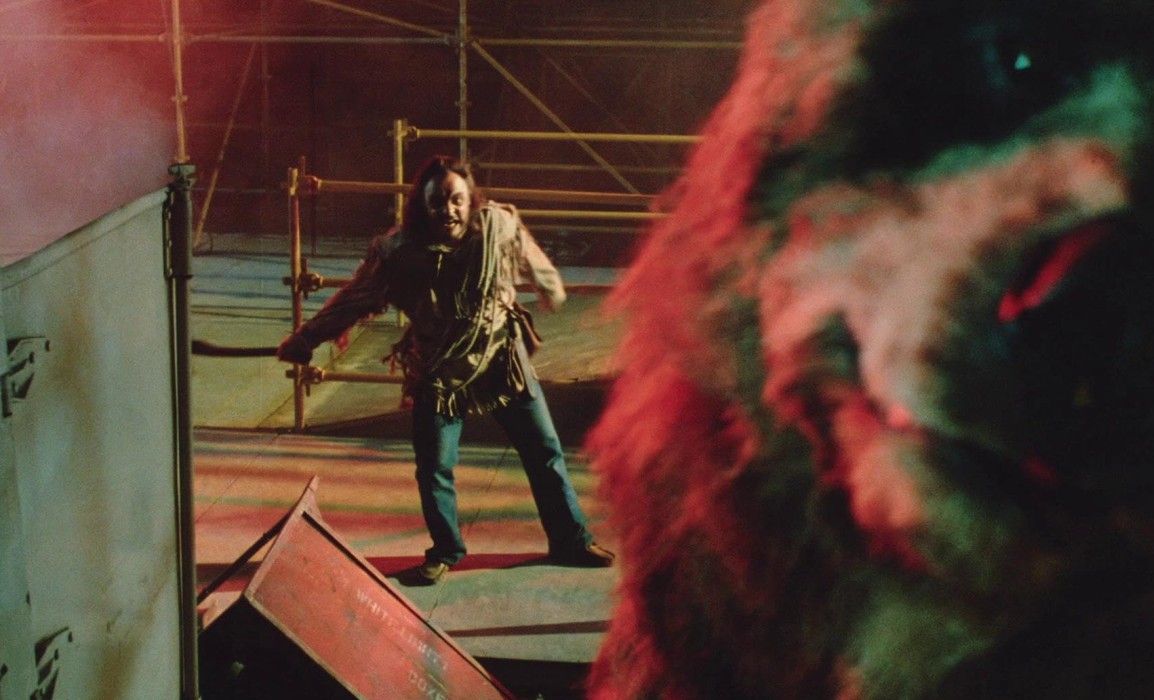
Grizzly II: Revenge (1983)
Rating: D-
Dir: André Szöts
Star: Steve Inwood, Deborah Raffin, John Rhys-Davies, Louise Fletcher
In hindsight, maybe Grizzly wasn’t so bad. This misbegotten sequel to it has experienced one hell of a tortured path to the screen. Its production originally started in 1983, but filming in Hungary was rudely interrupted when the money ran out. In 2007, a pirated copy of a workprint surfaced. It eventually sparked enough interest that a (somewhat) finished version was finally released in 2021, more than thirty-seven years after work started. And they really shouldn’t have bothered. Because it is genuinely terrible. At best, it’s a poor copy of the original, which was itself a poor copy of Jaws. At worst – and that’s most of the time – a laughably bad effort, which should have remained lost.
It begins with a mother bear seeing her cub shot by a hunter. Well, it’s a bad CGI bullet hitting a stock footage cub, in a spray of bad CGI blood, anyway. This triggers her into a killing spree, attacking any humans she encounters. Except, these sequences were among the scenes not filmed, so border on the nonexistent. After mauling minor characters, this brings her to a concert, with tens of thousands of attendees (footage recorded at a show by Nazareth and Toto Corlo, who were apparently really big draws in eighties Hungary) which local superintendent Eileene Draygon (Fletcher) had refused to call off. There, Mama Bear runs around, setting off fireworks (!) before wrestling with Gimli from Lord of the Rings and getting electrocuted or something.
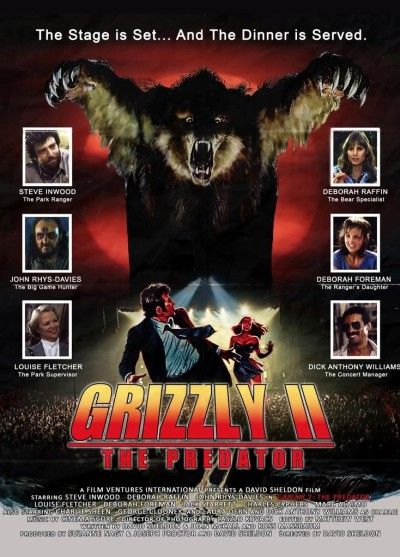 This is likely most remarkable for the greatest collection of no-names in one single scene. Early on, we meet three campers who become among the bear’s earliest victims. They are played by future stars, but then no more than nepo babies, Charlie Sheen (who got his SAG card for this), Laura Dern and George Clooney, This was even before the last-named’s infamous role in Return of the Killer Tomatoes. You can also spot Ian McNeice and Timothy Spall, providing you don’t blink. All of whom make considerably more impressive than the film’s technical stars. These are Inwood as park ranger Nick Hollister, and Raffin playing “bear management expert” Samantha Owens, whose idea of management appears to involve letting the bear eat whoever it wants.
This is likely most remarkable for the greatest collection of no-names in one single scene. Early on, we meet three campers who become among the bear’s earliest victims. They are played by future stars, but then no more than nepo babies, Charlie Sheen (who got his SAG card for this), Laura Dern and George Clooney, This was even before the last-named’s infamous role in Return of the Killer Tomatoes. You can also spot Ian McNeice and Timothy Spall, providing you don’t blink. All of whom make considerably more impressive than the film’s technical stars. These are Inwood as park ranger Nick Hollister, and Raffin playing “bear management expert” Samantha Owens, whose idea of management appears to involve letting the bear eat whoever it wants.
The only genuinely interesting thing here is insane French-Canadian hunter Bouchard (Rhys-Davies). Although a shameless copy of Quint from Jaws, there is a mad intensity to him which is genuinely entertaining. For example, when he gleefully tells an increasingly horrified Owens of his bear capture technique, which basically involves pulling them apart with horses. Had the film leaned into Bouchard more, this could have been a fun slab of nonsense. Instead, it’s almost entirely dull, not least in the lengthy, tedious festival footage, which does act as a good counter-argument to my belief that the eighties had the best music. When not boring, it is instead completely laughable and inept. The previously mentioned scene of Bouchard engaging in hand-to-hand combat with the beast is a high-water mark of incompetence, few films can hope to match.
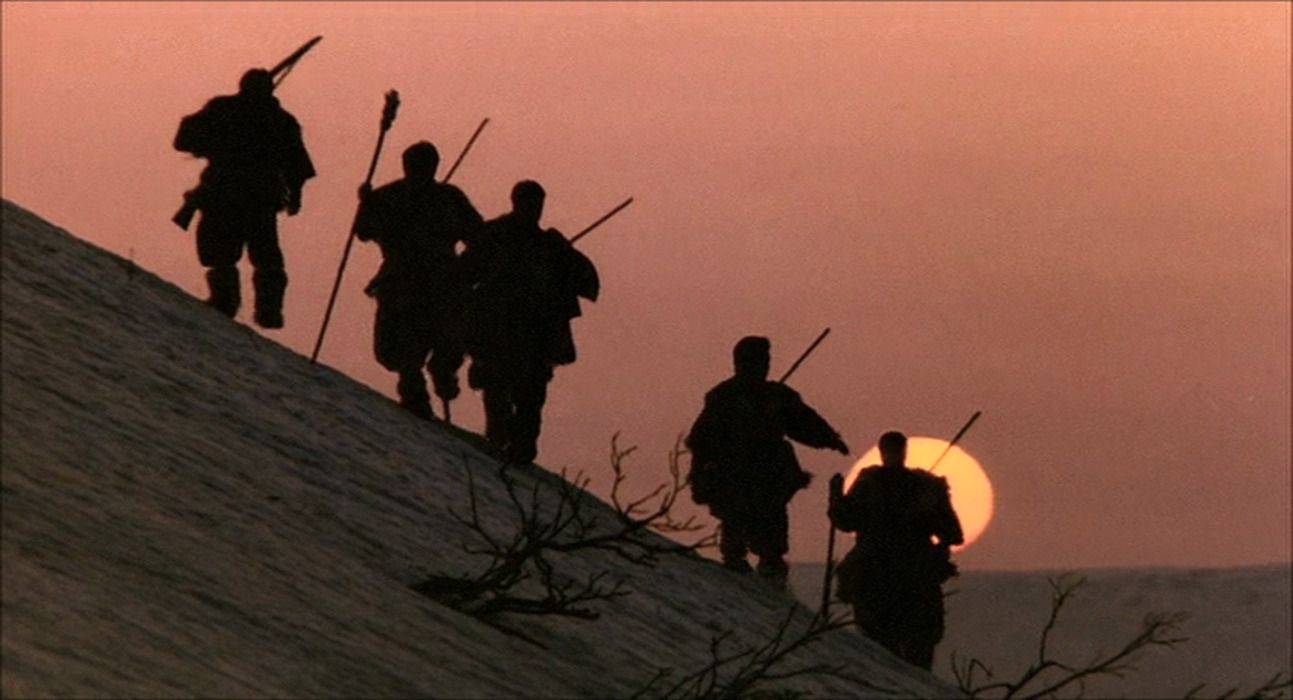
Yellow Fangs (1990)
Rating: C-
Dir: Sonny Chiba
Star: Hiroyuki Sanada, Mika Muramutsu, Bunta Sugawara, Hikaru Kurosaki
a.k.a. Remains: Beautiful Heroes
Yeah, it is the Sonny Chiba, who made his directorial debut with this, under the watchful eye of legend Kinji Fukasaku. However, it proved a dismal flop at the box-office, personally costing Chiba much of his own investment. It would take seventeen years before he would direct another film. This is inspired by the 1915 Sankebetsu brown bear incident, one of the worst ever recorded series of attacks. Over the course of a week, a single animal killed seven people, though the version here is dramatized in some ways. For example, the film bear specifically goes after and eats women, a pointed nod to one of the themes here. Misogyny is not limited to the animal kingdom, it appears.
It also extends time-line for the attacks to over a year. We join them already in progress, with the bear invading a home to attack the residents. A posse is quickly formed to go after the beast, but the trap they lay is interrupted by a girl and her dog attacking it. This is Yuki (Muramutsu, who has an immensely annoying, shrieky voice when irritated), whose family became victims twelve months previously, and has not sworn vengeance on the bear responsible. She partners with childhood friend Eiji (Sanada) to that end, but her presence on the mountain is not welcomed by Kasuke (Sugawara), the head of the hunters. For the mountain is a sacred site, from which women are barred. Unless being dragged there by a bear to be gnawed, I guess.
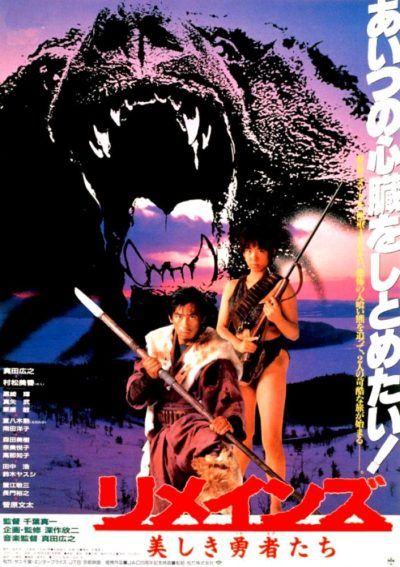 The main problem here is the structure, which leads to dire pacing. After Yuki shows up, we are then subjected to a lengthy flashback, in which the movie all but forgets about the killer bear. Instead, we get what could charitably be called social drama, except it’s not very dramatic either. Instead, there’s stuff about Yuki’s escape from an abusive employer, her guilt over the death of her family, Eiji’s intended marriage to the far less bear-huntery Mitsu, environmental concerns courtesy of Evil Mining Corp, Inc. etc. And I say “etc”, because I got bored with it all, and stopped taking notes after a certain point. Pretty scenery and a interesting soundtrack, with which Sanada was also involved, can only sustain my interest so long.
The main problem here is the structure, which leads to dire pacing. After Yuki shows up, we are then subjected to a lengthy flashback, in which the movie all but forgets about the killer bear. Instead, we get what could charitably be called social drama, except it’s not very dramatic either. Instead, there’s stuff about Yuki’s escape from an abusive employer, her guilt over the death of her family, Eiji’s intended marriage to the far less bear-huntery Mitsu, environmental concerns courtesy of Evil Mining Corp, Inc. etc. And I say “etc”, because I got bored with it all, and stopped taking notes after a certain point. Pretty scenery and a interesting soundtrack, with which Sanada was also involved, can only sustain my interest so long.
I began to practice my bear mating call, in hopes of luring the animal back. This eventually succeeded, with it attacking a festival, though it makes so much noise leaving, you wonder how it managed to sneak into town unnoticed. This sets up the finale, where Yuki, now the only woman who hasn’t been evacuated, strips down to her undies to attract the bear. Or, at least, the unconvincing furry who plays the bear for the film’s climax. Chiba does what he can to shoot around this, and demonstrates the good eye for action you would expect from the martial-arts master. It’s the unwelcome and clumsy stabs at social commentary that drag this down. You will likely understand why it took Sonny so long to sit in the director’s chair again.
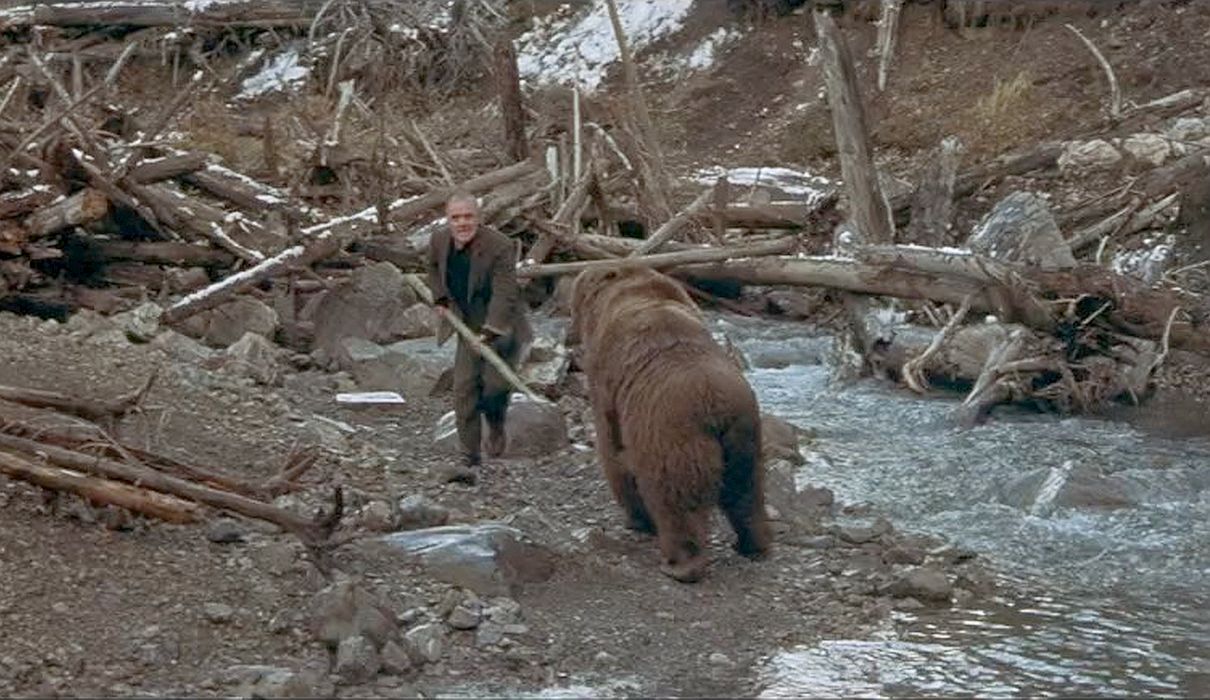
The Edge (1997)
Rating: B-
Dir: Lee Tamahori
Star: Anthony Hopkins, Alec Baldwin, Bart the Bear, Harold Perrineau
I didn’t have the author of Glengarry Glen Ross as likely to show up in our review of killer bear movies. Yet here we are, with this David Mamet-scripted wilderness adventure. If you’ve seen any of his works, you’ll know his style is dialogue heavy, Wikipedia saying it’s “marked by a cynical, street-smart edge, [and] has come to be called Mamet speak.” As soon as I saw his name in the opening credits, I wondered how it would translate to an ursine stalk and swipe movie. The answer? Not badly, because the film is as much about the disintegrating relationship between billionaire businessman Charles Morse (Hopkins), and photographer Bob Green (Baldwin), as they try to survive in said wilderness.
The key to the friction is Morse’s suspicion, that Green is having an affair with his model wife, Mickey (Elle McPherson). Which makes sense, because she is basically half her husband’s age, and seeing them in bed at the beginning is a tad creepy. They’re in Alaska for a photo shoot, until a plane crash sends Morse, Green and assistant Stephen (Perrineau) off the grid and into trouble. We know Stephen is in trouble because he a) doesn’t get a last name, b) is black, and c) is not a big star. So when a large, hungry Kodiak (Bart) starts stalking the trio, it’s not hard to guess who is going to be first on the menu.
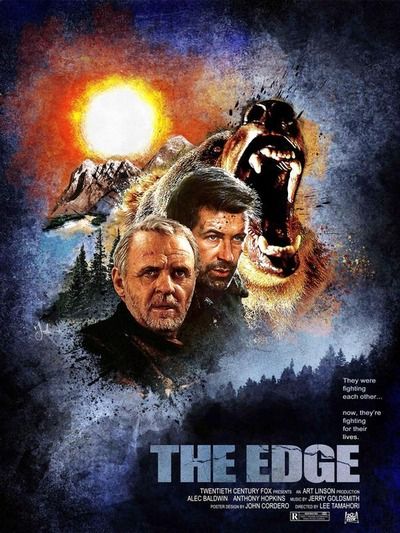 The survivors then have to overcome the increasing personal animosity in order to escape alive. It doesn’t help that Bob is basically a whiny little bitch, while Charles is far more interesting and well-rounded, although his position as a fount of wilderness knowledge is negated when he leads the group in a circle. Watching the pair of them bickering, is nowhere near as much fun as seeing them fend off their pursuer. From their first encounter, leading to a terrifying escape across a gorge, through the brutal demise of… oh, figure it out, to the final battle, these are impressive and well-handled sequences, anchored by the genuinely scary presence of the 9’7″ tall, 1,500-pound Bart. Sadly, it was close to his last film, as he died in May 2000.
The survivors then have to overcome the increasing personal animosity in order to escape alive. It doesn’t help that Bob is basically a whiny little bitch, while Charles is far more interesting and well-rounded, although his position as a fount of wilderness knowledge is negated when he leads the group in a circle. Watching the pair of them bickering, is nowhere near as much fun as seeing them fend off their pursuer. From their first encounter, leading to a terrifying escape across a gorge, through the brutal demise of… oh, figure it out, to the final battle, these are impressive and well-handled sequences, anchored by the genuinely scary presence of the 9’7″ tall, 1,500-pound Bart. Sadly, it was close to his last film, as he died in May 2000.
This was actually a reunion between Hopkins and Bart, as they appeared together in Legends of the Fall. I’d have been fine seeing more of them, and less of Baldwin, although he’s likely necessary because Bart wasn’t very good at that Mamet speak. There’s no question, the film finds an extra gear whenever the bear shows up. Tamahori, back before his career was unfortunately derailed by… [gestures vaguely] does solid work capturing the “Alaskan” – in reality, Canadian – landscape. It’s definitely quality, above most in the field and if the lofty ambitions of Mamet’s script are not all successful, at least it has lofty ambitions. Viewers may choose to discuss after the movie, whether they would prefer to spend time with Bob, or get eaten by Bart.

Grizzly Man (2005)
Rating: B
Dir: Werner Herzog
Star: Timothy Treadwell, Werner Herzog, Jewel Palovak, Sam Egli
Treadwell was the man who, for more than a decade, spent summers living up in Alaska among the grizzly bears. He had a passion for animals, positioning himself as their protector. Not all the bears felt similarly. In October 2003, Treadwell and his companion Amie Huguenard were killed and eaten by a bear. Audio footage of the attack was recorded. The quixotic endeavour of Treadwell and its ironic resolution resonated with Herzog – himself no stranger to the great outdoors and the insanity it can breed – who assembled a documentary on the life and death of the wilderness ddweller. What was Treadwell trying to accomplish? Was he the altruistic ecowarrior he portrayed? Or was there self aggrandisement involved?
As depicted here, it’s a bit of both. Treadwell appears to have been a complex character, prone to flights of fancy. He fabricated a background for himself in which he came from the Australian outback, and I don’t believe the story he lost out to Woody Harrelson for a role in Cheers. But there was clearly a genuine passion for wildlife, and bears in particular, misplaced and dumb a lot of his actions clearly were. Herzog speaks to an Alaskan native, Sven Haakanson Jr., who is aghast at what the outsider did: “You don’t invade their territory… Timothy Treadwell crossed a boundary that we have lived with for 7,000 years.” These particular bears didn’t really need protecting either, from what I’ve read.
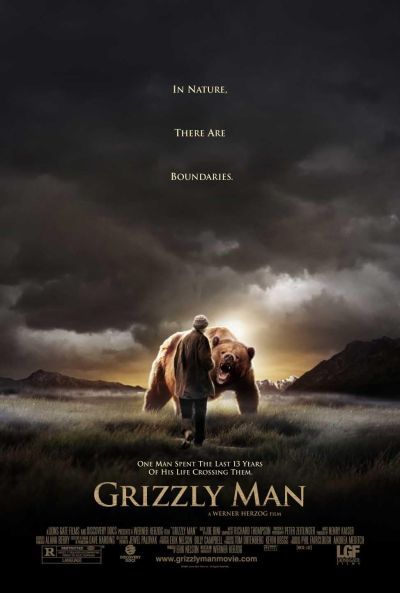 Having said that, he didn’t deserve an unrepentantly grim fate, one of the responders explaining, “We hauled away four garbage bags of people out of that bear.” That’s before we get to the audio snuff tape. We don’t hear it. A coroner describes the recording, and we see the reaction of Herzog and a friend of Treadwell, Jewel Palovak, listening to it. That’s enough: the director advises her to destroy the tape, Herzog later calling it, “the most terrifying thing I’ve ever heard in my life.” And that’s something, coming from a man who made multiple films with Klaus Kinski. [A relationship likely referenced when Herzog says of Treadwell in his later stages, “The actor in his film has taken over from the film-maker. I have seen this madness before on a film set…”]
Having said that, he didn’t deserve an unrepentantly grim fate, one of the responders explaining, “We hauled away four garbage bags of people out of that bear.” That’s before we get to the audio snuff tape. We don’t hear it. A coroner describes the recording, and we see the reaction of Herzog and a friend of Treadwell, Jewel Palovak, listening to it. That’s enough: the director advises her to destroy the tape, Herzog later calling it, “the most terrifying thing I’ve ever heard in my life.” And that’s something, coming from a man who made multiple films with Klaus Kinski. [A relationship likely referenced when Herzog says of Treadwell in his later stages, “The actor in his film has taken over from the film-maker. I have seen this madness before on a film set…”]
I think this was tragedy born of hubris, an area which has frequently been at the core of Herzog’s work. Treadwell’s vision of bears ended up at odds with the reality. That it took so long before disaster struck is the most surprising thing – likely a result of these bears having easier sources of food than foolish humans. Large, omnivorous animals like bears, are your friends only until the salmon runs out, at which point harsh language is likely to provide insufficient protection. Otherwise, I perhaps don’t entirely disagree with the critical letter sent to Treadwell’s friend, Marc Gaede, which concludes, “We need to somehow drastically increase the number of bears in America. Especially in such key spots as the Berkeley campus.” But a scene where a fox steals Treadwell’s baseball cap and runs off with it, made me wonder if the foxes killed him, and framed the bears…
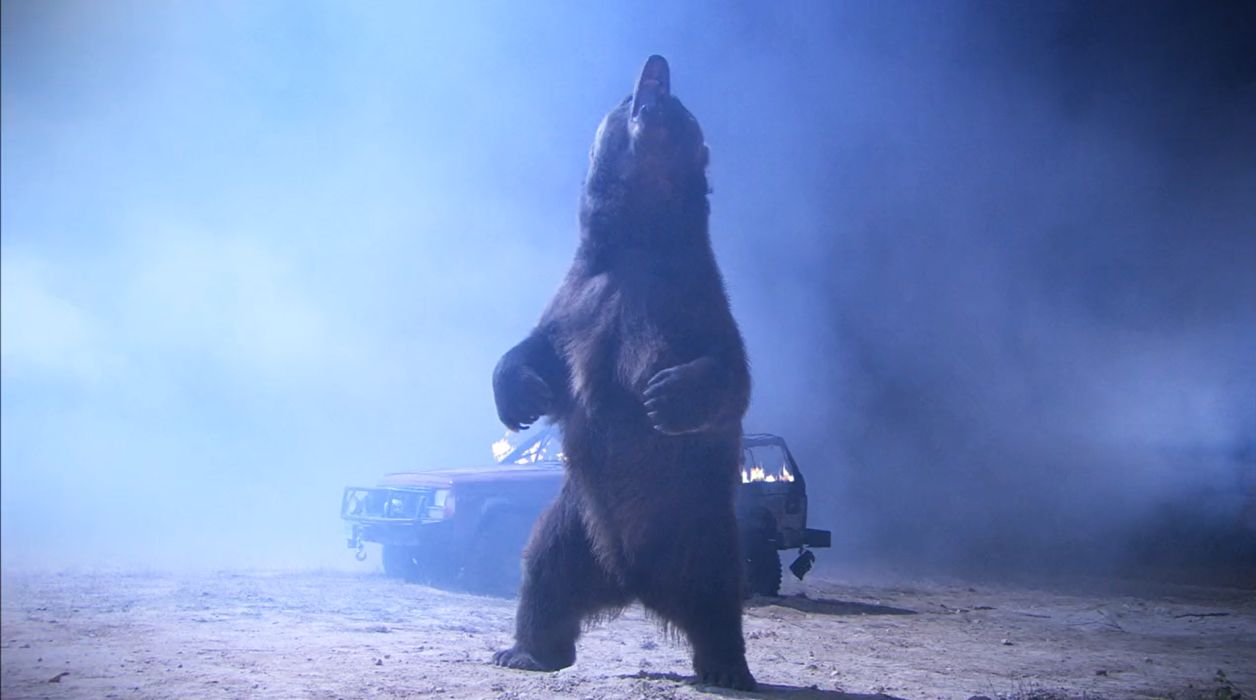
Grizzly Rage (2007)
Rating: D
Dir: David DeCoteau
Star: Tyler Hoechlin, Graham Kosakoski, Brody Harms, Kate Todd
I put this movie to one side before getting up the energy to review it, due to the number of red flags. Sci Fi Original Movie being one. Director DeCoteau being another. He’s best known here as director of the gayest vampire film ever. And I mean that, in both non-derogatory and thoroughly derogatory senses. I was not exactly eager to see his take on this genre. My concerns proved justified: the best thing I can say about Grizzly Rage, is that it’s not gay (in the literal meaning). I suspect a DeCoteau movie which was gay, would end up taking a very different approach to the topic of “killer bears”.
This, however, barely has an original thought in its head. Four teens decide to celebrate their high-school graduation with a trip into the wilderness. Their Jeep runs over a cub, crashes off the road and cracks its radiator. Momma Bear is less than happy, and begins hunting the quartet of largely obnoxious young people, to make them pay for their cubicide. Those who are concerned about the future of our species, will likely be firmly on #TeamBear. For she may be the most intelligent lifeform present on screen. At least there’s footage of a real bear here, though I’m doubtful the animal was ever on set at the same time as the human actors. What rare interaction you get, is carried out with an obviously fake bear paw on a stick.
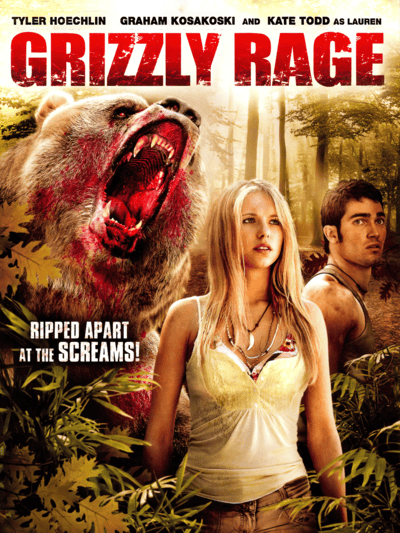 Most of the time though, it’s cutting between shots of the victims thrashing, and the bear roaring, climaxing in a money shot of CGI blood splashing across the camera lens. None of it is in the slightest bit convincing: to be fair, this is likely down to the “made for television” environment, so I can’t blame DeCoteau for that. What I can blame him for, to varying degrees, are characters which are barely an excuse, dialogue that sounds like a fifty-year-old’s idea of how young people communicate, and actors like Kosakoski. He was twenty-five, and therefore convincing as a high-school student, only if his character had been forced to retake his senior year, seven times in a row. [He did star in The Brotherhood IV two years previously. Draw your own conclusions]
Most of the time though, it’s cutting between shots of the victims thrashing, and the bear roaring, climaxing in a money shot of CGI blood splashing across the camera lens. None of it is in the slightest bit convincing: to be fair, this is likely down to the “made for television” environment, so I can’t blame DeCoteau for that. What I can blame him for, to varying degrees, are characters which are barely an excuse, dialogue that sounds like a fifty-year-old’s idea of how young people communicate, and actors like Kosakoski. He was twenty-five, and therefore convincing as a high-school student, only if his character had been forced to retake his senior year, seven times in a row. [He did star in The Brotherhood IV two years previously. Draw your own conclusions]
Lauren Findley (Todd) is the only gash on the trip, presumably present so things don’t appear too gay for basic cable. She is, however, the only one who would not lose a pop quiz to a slug, being the party member who questions the last-minute decision to change destination and go to, I kid you not, a toxic waste dump. This plot-thread is entirely irrelevant, since no suggestion is made that, for example, Momma Bear snacked down on a discarded barrel of expired steroids. I will pronounce myself somewhat satisfied with an ending that’s certainly darker than the typical Sci Fi Original Movie. In just about every other way though, this is bad, even by the low standards if that outlet.
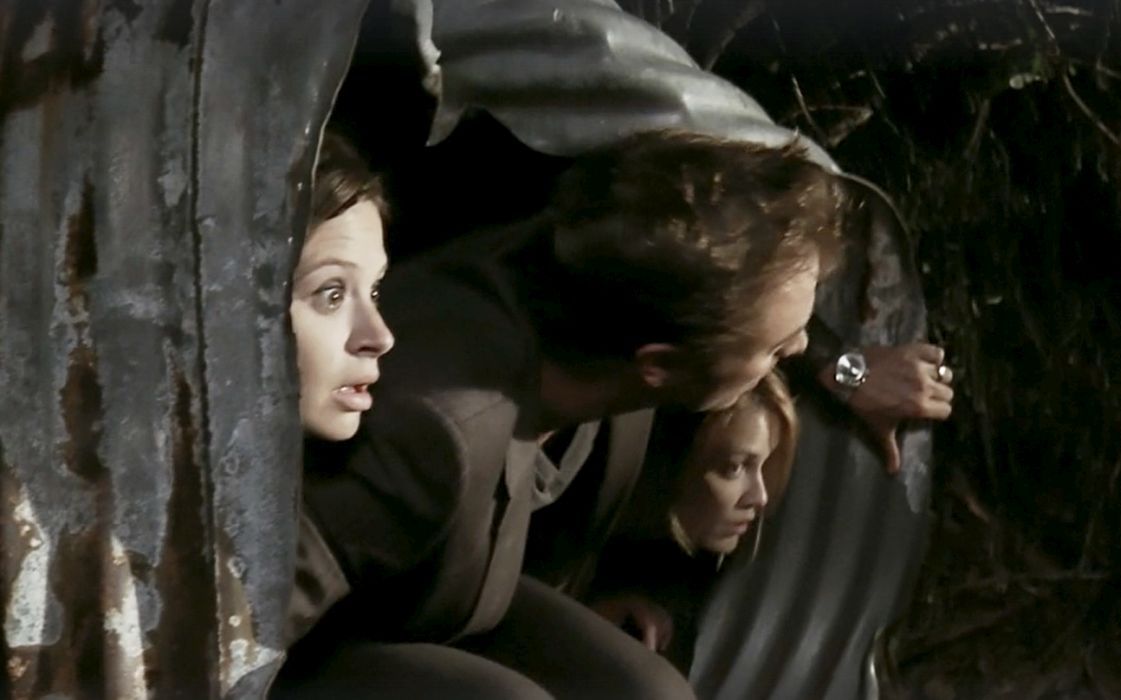
Bear (2010)
Rating: C+
Director: Roel Reiné
Stars: Brendan Michael Coughlin, Patrick Scott Lewis, Mary Alexandra Stiefvater, Katie Lowes
There are a lot of bad reviews of this, many of which criticize, for example, the “unpleasant characters and a stupid story.” I’m not inclined to disagree with that assessment. Except, those are precisely the reasons why I kinda enjoyed this. It’s not often you get to see a cross between a wilderness survival flick and an episode of Jerry Springer. OK, that isn’t the kind of bizarre genre crossover you’d want to watch on a regular basis. As a one-off though, I had fun. Two brothers, each with their other halves, are on the way to a dinner with Dad, when a supposed short-cut is followed by car trouble, leaving the four stranded.
A young bear shows up, and is met by obnoxious older sibling, Sam the stockbroker (Lewis) unloading an entire clip into it. Problem solved… until Papa Bear shows up and rolls the car over, trapping the quartet inside. Younger brother Nick (Coughlin), an aspiring rock musician, believes this is personal. He thinks the animal is intent on taking revenge for the ursicide, citing native folklore which says animals can feel emotion. Sam rejects this, but since he used all his ammo in the cub, his judgment is clearly suspect. As the night wears on and escape attempts prove futile, tensions mount. Especially after Sam’s wife Liz (Stiefvater) announces she is pregnant – and the father might not necessarily be her husband. Where’s a paternity test when you need one?
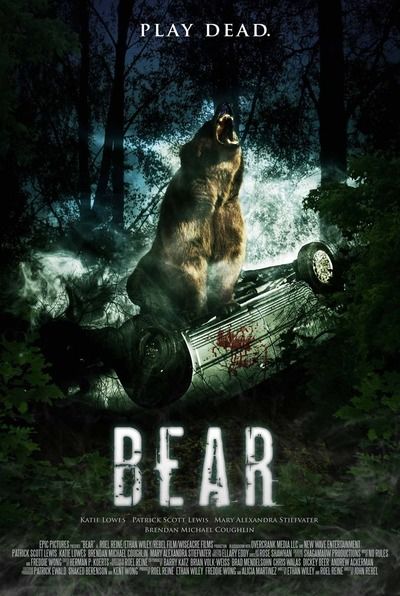 Between the disagreeable characters and the initial set-up, it feels as if you might be intended to root for the bear. In that, its closest cousin might be Orca, though especially at the end, Reiné does appear to be ramping up the mystical elements, imbuing the creature with human or maybe superhuman traits. For instance, after Sam tries to run for help, the bear doesn’t kill him, but drags Sam back to the car. This is either, “So that he could kill all of us together” (Sam), or because, “That bear knows more about us than we do ourselves” (Nick). I’m not certain which makes less sense: neither sit well with the familial soap-opera unfolding inside the vehicle.
Between the disagreeable characters and the initial set-up, it feels as if you might be intended to root for the bear. In that, its closest cousin might be Orca, though especially at the end, Reiné does appear to be ramping up the mystical elements, imbuing the creature with human or maybe superhuman traits. For instance, after Sam tries to run for help, the bear doesn’t kill him, but drags Sam back to the car. This is either, “So that he could kill all of us together” (Sam), or because, “That bear knows more about us than we do ourselves” (Nick). I’m not certain which makes less sense: neither sit well with the familial soap-opera unfolding inside the vehicle.
Bonus points for the presence of Lowes as Nick’s girlfriend Christine, whom Chris recognized from her role, a couple of years later, as Quinn Perkins in Scandal. Shame she couldn’t call in Olivia Pope here, to make that face at the bear. I did think Reiné handled the attack sequences quite well, combining a real bear (played by one called Blue) with a man in a suit, to decent effect. Nice to see him doing something other than direct-to-video sequels too. This worked best for me when embracing its inner loopiness, although sadly, the moment where it looked like it was about to turn into a Cocaine Bear prequel, did not go anywhere. Amusingly daft, it is at least attempting something a bit different from the norm.
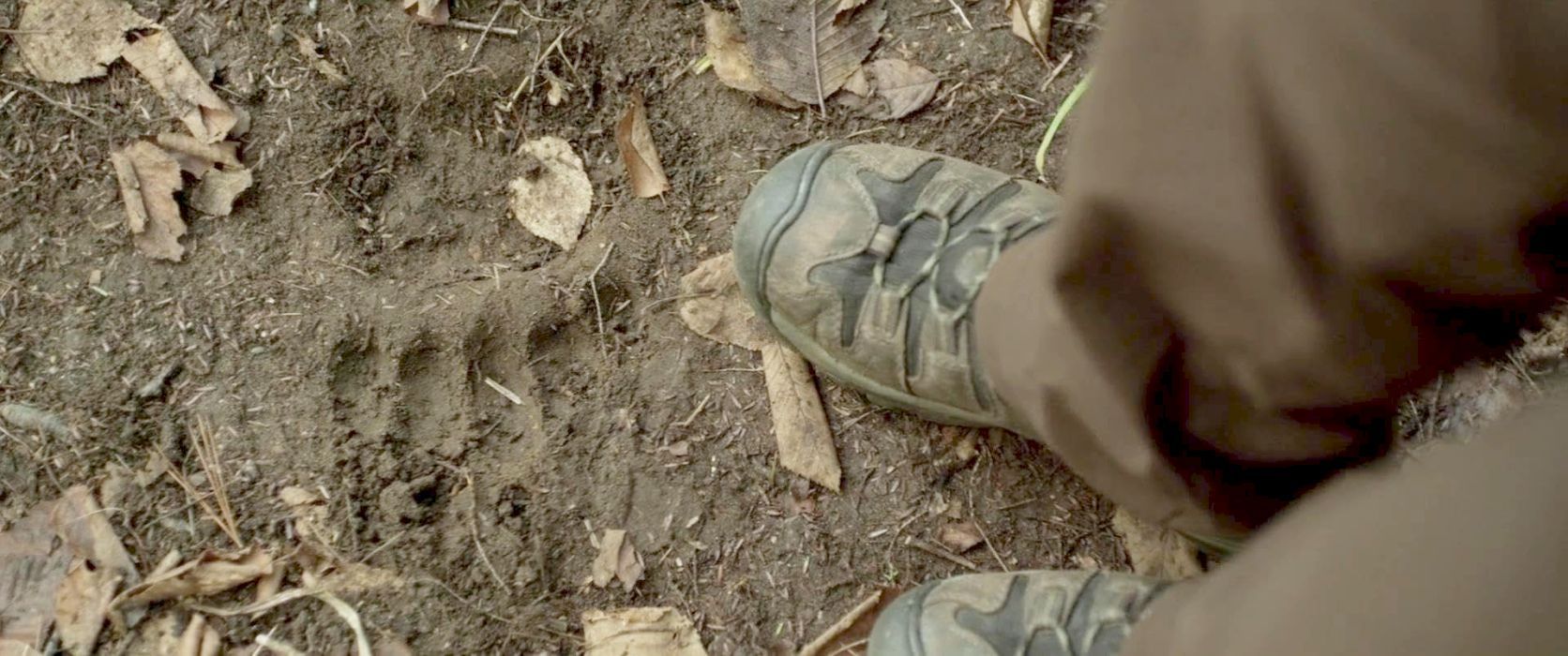
Backcountry (2014)
Rating: C+
Dir: Adam MacDonald
Star: Missy Peregrym, Jeff Roop, Eric Balfour, Nicholas Campbell
This is the kind of film where you can sit smugly on your comfortable sofa, shaking your head sadly at the poor choices made by the characters. The first and biggest, being the decision to go camping in the first place. Trust me when I say, this is not a mistake we will be making. Indeed, this might be a movie produced by the Hotel Owners’ Association of North America, because if you watch this and still have an interest in a vacation not involving room service, you simply aren’t paying attention. Not least because this is based on a true story, when a couple were attacked by a bear while on holiday in northern Ontario.
Here, it’s Alex (Roop) who drags him somewhat unwilling girlfriend Jenn (Peregrym) to his childhood haunt of Nibookaazo Provincial Park. [Fun fact: in Ojibwe, Nibookaazo translates as “Pretend to be Dead”] He plans to propose at a specific spot, but turns out his wilderness navigational skills aren’t as good as he thinks, after refusing the offer of a map. Making matters worse, he deliberately left Jenn’s cellphone back in the car, to avoid it being a distraction. Things get ominous early on, when they encounter suspicious hiker Brad (Balfour). However, it gradually becomes clear that a bigger, badder predator than Brad is to be found in the woods. There’s a black bear in the area, and it’s looking to fatten itself up on a hiker buffet, before going into hibernation for the winter.
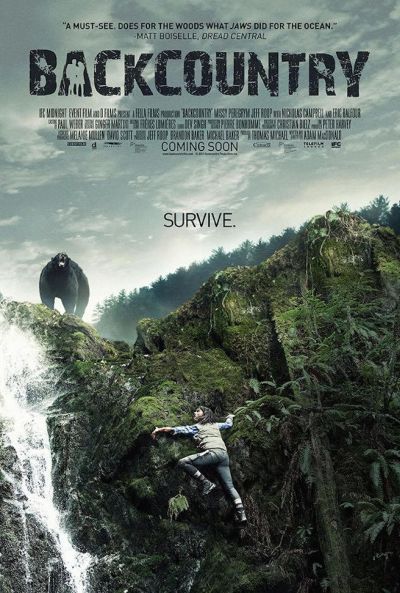 You will have to sit through a good deal of set-up to get to the meat of the matter. The bear itself doesn’t appear until 48 minutes in, and then is still only glimpsed in silhouette, prowling around and snorting (derisively, I like to think) outside the couple’s tent. If only tents, unlike hotel rooms, came with deadbolts. The ursine creature does loom over things regardless, to the point the obvious red herring of Brad seems a pointless distraction. When it finally makes its move, however, it’s a brutal and unpleasant sequence, getting up there with The Revenant, I’d say. You don’t necessarily see a great deal: however, the audio work, in particular the screams of the victim, is excellent, and harrowing in the extreme.
You will have to sit through a good deal of set-up to get to the meat of the matter. The bear itself doesn’t appear until 48 minutes in, and then is still only glimpsed in silhouette, prowling around and snorting (derisively, I like to think) outside the couple’s tent. If only tents, unlike hotel rooms, came with deadbolts. The ursine creature does loom over things regardless, to the point the obvious red herring of Brad seems a pointless distraction. When it finally makes its move, however, it’s a brutal and unpleasant sequence, getting up there with The Revenant, I’d say. You don’t necessarily see a great deal: however, the audio work, in particular the screams of the victim, is excellent, and harrowing in the extreme.
Thereafter, it’s a case of the survivor trying to make their way out of the park to safety, with the bear largely back to lurking. To be honest, the film peaks with the attack. Nothing thereafter can match up, though a sequence involving the descent of a waterfall has its moments of tension. It’s hard to feel much sympathy for characters, who are largely suffering the consequences of their own actions, particularly in the case of Alex. It feels like MacDonald is vaguely seeking to make some statement about masculine hubris: this is the wilderness equivalent of refusing to stop and ask for directions. Any such point may well stick in the mind less well than the rending and gnawing.
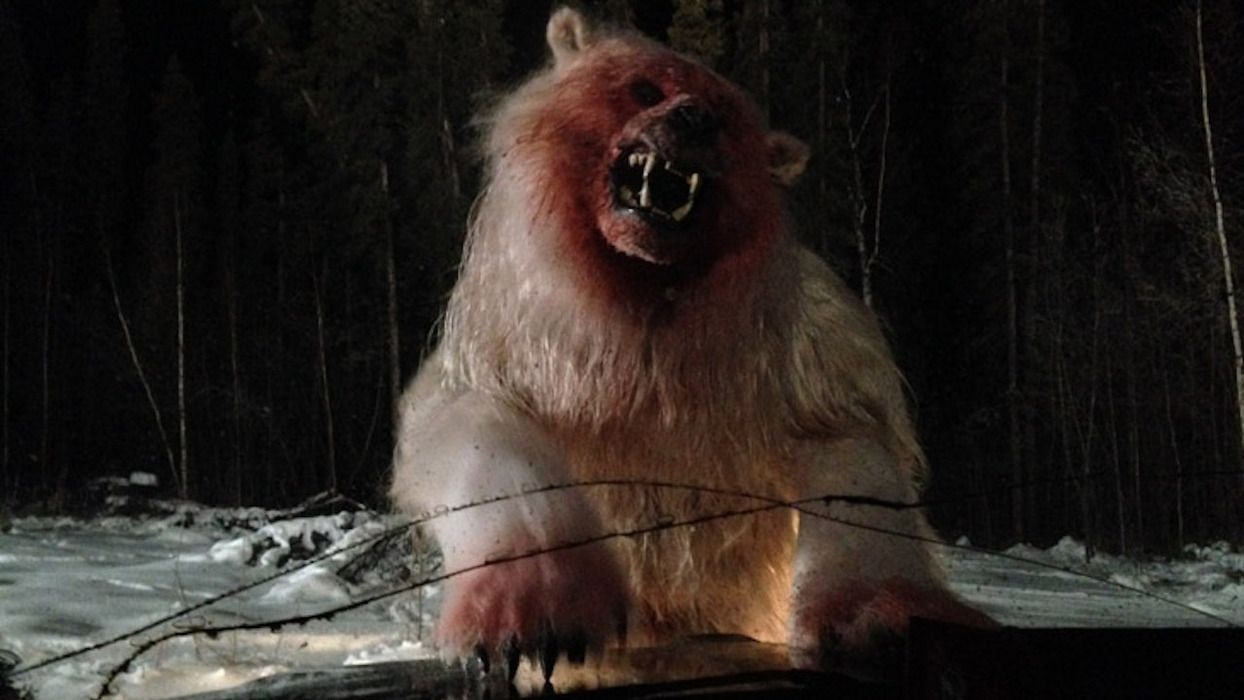
Unnatural (2015)
Rating: C+
Dir: Hank Braxtan
Star: James Remar, Sherilyn Fenn, Ron Carlson, Allegra Carpenter
a.k.a. Maneater
This hits a number of the same beats as our When Chinese Animals Attack films. There is an evil corporation, carrying out dubious genetic experiments on its fauna subjects. The test critter escapes and goes on a rampage. We get a wise native local, irritating people who deserve to be eaten, a serious scientist with respect for nature, and random eye-candy. In this case, events unfold in the Alaskan wilderness, where fashion photographer Brooking (Carlson) has taken his bimbo models for a shoot. The creature in question is a bear, into which the Clobirch corporation, under scientist Dr. Hanna Lindval (Fenn), has injected wolf DNA – for reasons which are never adequately explained.
It escapes, and begins behaving less like a wild animal, and more like the killer in a slasher flick. We get sequences shot in Bear-o-vision, and it is conveniently able either to make scary noises, or move in complete silence, as necessary for the movie. Until the final reel, we don’t see much of it, though I was amused by it reaching up through the ice, to drag a bikini-clad model to her doom. For the first hour, we are thus largely left in the hands of the human cast. This is better than most, also including Remar as Martin Kakis, operator of the wilderness lodge round which the bear prowls; Ray Wise playing the Clobirch CEO; and Graham Greene (RIP) as the token indigenous guy mentioned above.
 However, there is just not enough bear here for my tastes, with the barest (pun not intended, for once) glimpse of a paw about as much as you get during this stage. I will say, the foley work is up to scratch, with a wide range of suitably meaty sounds. I can honestly say, I have never before seen subtitles which read – accurately, I should add – “(flesh squelching) (screaming stops)”. Brooking is the most irritating of the characters: while undeniably intentional, the film would have been improved by him having a considerably shorter lifespan. The corporate malfeasance could have been better integrated too, beyond the initial Clobirch promotional video. The mention of things like global warming seem a token gesture, and the ending suggests no lessons have been learned.
However, there is just not enough bear here for my tastes, with the barest (pun not intended, for once) glimpse of a paw about as much as you get during this stage. I will say, the foley work is up to scratch, with a wide range of suitably meaty sounds. I can honestly say, I have never before seen subtitles which read – accurately, I should add – “(flesh squelching) (screaming stops)”. Brooking is the most irritating of the characters: while undeniably intentional, the film would have been improved by him having a considerably shorter lifespan. The corporate malfeasance could have been better integrated too, beyond the initial Clobirch promotional video. The mention of things like global warming seem a token gesture, and the ending suggests no lessons have been learned.
Fortunately, it does find a new gear down the stretch. When we see the beast, it’s better than I expected, given the reticence of the movie about showing it, to that point. It doesn’t look completely like a polar bear – presumably due to the injection of wolf. The climax bumps up the rating half a grade, due to the first occurrence (of which I’m aware) of Chekhov’s Ice Auger. This is driven into the bear-wolf by Nakos, along with a yell: “Add this to your DNA!” Because it’s a spiral, see? Additional helpings of such dumb excess, throughout the movie, would have been welcome. It’s still one more memorable moment than many entries in this genre can provide.
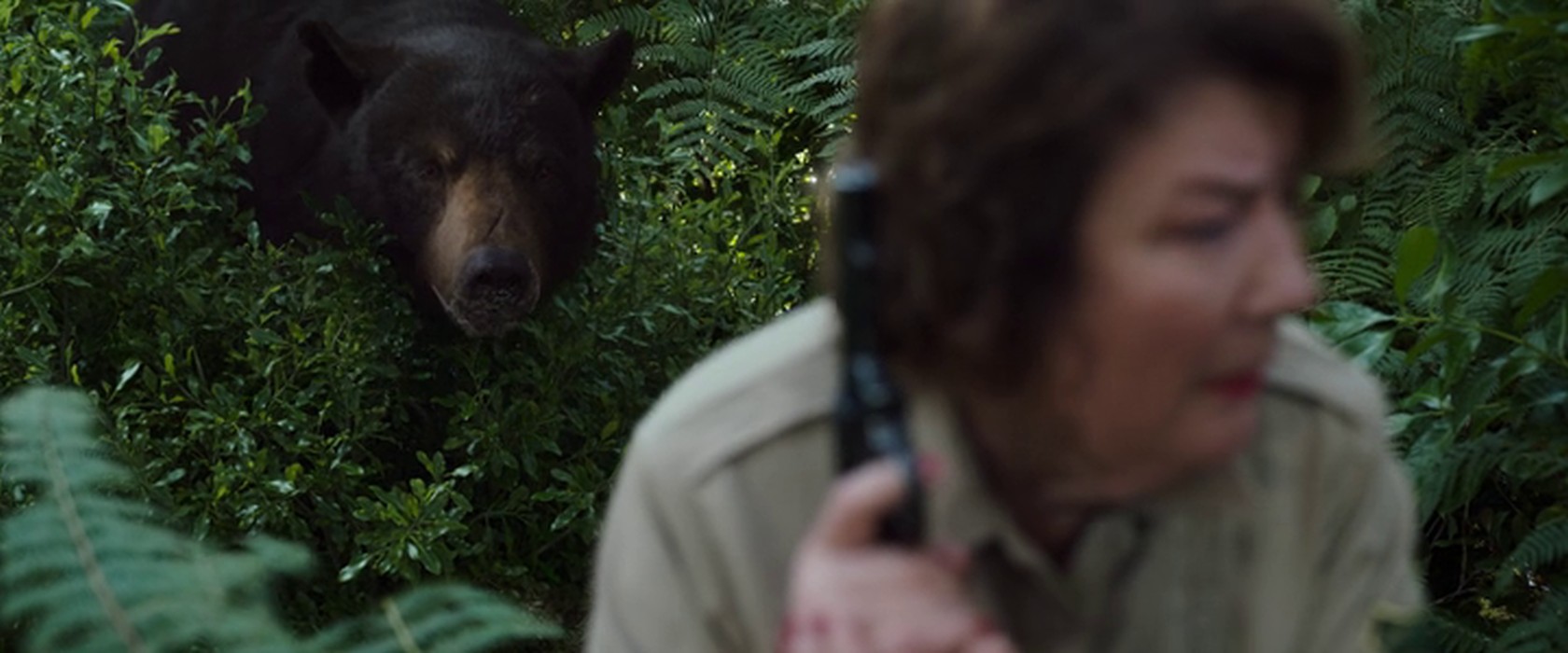
Cocaine Bear (2023)
Rating: C+
Dir: Elizabeth Banks
Star: Keri Russell, Alden Ehrenreich, O’Shea Jackson Jr., Christian Convery
This is the most viral movie title since Snakes on a Plane. It doesn’t manage to be quite as successful, only fully embracing the lunacy of its central concept in intermittent fashion. However, the points when it does, leave this an adequately entertaining experience. Probably not quite the movie on which the late Ray Liotta would have chosen to go out, but few of us get that privilege. It does have more basis in fact than Snakes. A bear did indeed consume cocaine dumped from a plane. But it was relatively small (175 lbs) and rather than going on the rampage, it died on the spot. The stuffed corpse is now on display in a Kentucky souvenir store.
This harsh reality would not have made for much of a story – Cocaine Overdose Bear, or possibly Belushi Bear. So it is punched up with various groups converging to the Georgia national park, on which the coke was dropped. There are drug dealer minions Daveed (Jackson) and Eddie (Ehrenreich), seeking to recover the drugs for their boss (Liotta). Tennessee detective Bob is also present, a dead drug-runner having fallen from the sky on his turf. And local mom Sari (Russell) is seeking her daughter Dee Dee, who skipped school with her friend Henry (Convery) to visit the park. All of them will encounter momma bear, who has developed a nasty coke habit, and wants to fight anyone unfortunate enough to cross her path.
 When that’s what the film delivers, it’s gory and glorious. The best section is likely the bear laying siege to the ranger station, followed by an ambulance showing up. This results in the scene, understandably showcased in the trailer, where the coke-enraged bear pursues the vehicle. [Jaunty Depeche Mode tune, Just Can’t Get Enough will never be the same again] Similarly, the sequence involving two trees, with a potential victim up each, is a well-staged slice of black comedy. It’s a shame the same cannot be said when the ursine villainess is off screen. It’s definitely a problem if a CGI creation is the most memorable character in your movie. That’s the case here: we finished watching it an hour ago, and I literally cannot remember anybody’s name.
When that’s what the film delivers, it’s gory and glorious. The best section is likely the bear laying siege to the ranger station, followed by an ambulance showing up. This results in the scene, understandably showcased in the trailer, where the coke-enraged bear pursues the vehicle. [Jaunty Depeche Mode tune, Just Can’t Get Enough will never be the same again] Similarly, the sequence involving two trees, with a potential victim up each, is a well-staged slice of black comedy. It’s a shame the same cannot be said when the ursine villainess is off screen. It’s definitely a problem if a CGI creation is the most memorable character in your movie. That’s the case here: we finished watching it an hour ago, and I literally cannot remember anybody’s name.
It seems to be an issue with Banks, that she doesn’t understand why people are in the cinema. Her misconceived Charlie’s Angels reboot unilaterally decided to replace women kicking serious ass while looking good, and focus on Kristen Stewart playing an ugly lesbian. #SoBrave. Similarly, we do not care about Sari’s relationship with Dee Dee. We are here to see an animal off its tits, ripping faces. But Banks instead edited Liotta’s death scene, saying, “We didn’t want it to feel exploitative or unnecessary.” Sorry, Lizzy: I suspect that boat sailed… oh, I dunno, when you called your movie Cocaine Bear. We are 100% here for the unnecessary and the exploitative. Needs more bear. Or, possibly, Banks needed more cocaine, I’m not certain.
